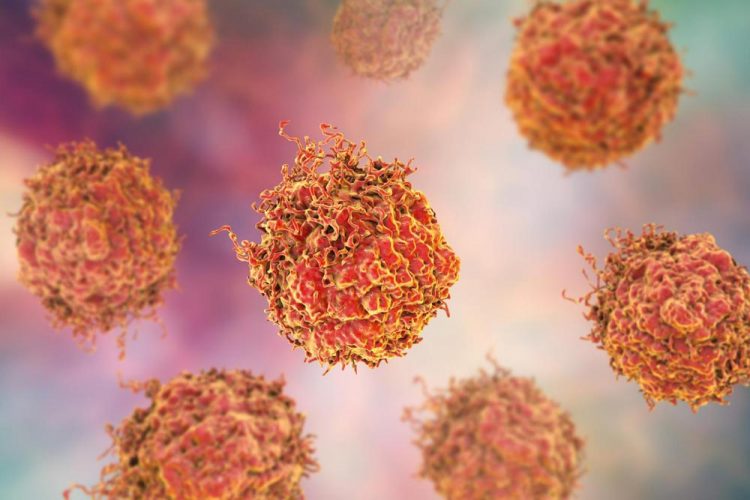Blocking specific protein could provide new treatment for deadly form of prostate cancer

Blocking CDK7 sets off a chain reaction that results in the death of prostate cancer cells that have spread and are resistant to standard therapies. Credit: Penn Medicine
Blocking a kinase known as CDK7 sets off a chain reaction that results in the death of prostate cancer cells that have spread and are resistant to standard therapies, according to a new study from researchers in the Abramson Cancer Center at the University of Pennsylvania.
The team identified the role of CDK7 as the on/off switch that controls Med-1, a process that works in partnership with the androgen receptor to drive prostate cancer growth. Researchers show turning the switch off eventually leads to the death of cancer cells in mice. Cancer Discovery published the findings today.
Androgen deprivation therapy is a standard approach to treating prostate cancer, but over the course of treatment, a majority of patients will eventually become resistant to the therapy, allowing the cancer to grow and spread.
This is referred to as metastatic castration-resistant prostate cancer (CRPC). There are two drugs approved by the U.S. Food and Drug Administration for these cases, but patients see little or no long-term survival benefit from these therapies.
Since the androgen receptor (AR) continues to be the main the driver of cancer growth in CRPC, taking away its function is still critical. Given the disease's resistance to therapies that try to take on AR directly, a new approach is needed.
While these cancers do not have additional mutations or other genetic overexpression, the Penn team was still able to identify a new target thanks to what researchers called “AR's co-pilot.”
“We know that AR does not work alone; that it needs Med-1 as its partner,” said the study's senior author Irfan A. Asangani, PhD, an assistant professor of Cancer Biology in the Perelman School of Medicine at the University of Pennsylvania. “Our study found a way to turn off Med-1, leaving AR without its co-pilot which means the cancer cannot grow and the cells eventually die.”
Using an inhibitor to turn off CDK7 led to the death of CRPC cells in both the lab setting and in animal models. Researchers also saw very limited off-target effects of this approach, since healthy cells have redundancies in place to deal with the loss of Med-1, meaning only the cancer cells end up dying off.
“Our theory is that these cancer cells are addicted to Med-1 and AR but other cells are not, so we're essentially cutting them off from their addiction,” Asangani said.
CDK7 inhibitors are already being tested in phase I clinical trials for other cancers – including leukemia, lung cancer, glioblastoma, and breast cancer – but Asangani said this study shows the rationale for testing them in CRPC.
Reyaz ur Rasool, Ramakrishnan Natesan, and Qu Deng are co-first authors on the study. Other Penn authors include Shweta Aras, Priti Lal, Samuel Sander Effron, Erick Mitchell-Velasquez, Jessica M. Posimo, Lauren E. Schwartz, Daniel J. Lee, and Donita C. Brady.
###
Penn Medicine is one of the world's leading academic medical centers, dedicated to the related missions of medical education, biomedical research, and excellence in patient care. Penn Medicine consists of the Raymond and Ruth Perelman School of Medicine at the University of Pennsylvania (founded in 1765 as the nation's first medical school) and the University of Pennsylvania Health System, which together form a $7.8 billion enterprise.
The Perelman School of Medicine has been ranked among the top medical schools in the United States for more than 20 years, according to U.S. News & World Report's survey of research-oriented medical schools. The School is consistently among the nation's top recipients of funding from the National Institutes of Health, with $425 million awarded in the 2018 fiscal year.
The University of Pennsylvania Health System's patient care facilities include: the Hospital of the University of Pennsylvania and Penn Presbyterian Medical Center–which are recognized as one of the nation's top “Honor Roll” hospitals by U.S. News & World Report–Chester County Hospital; Lancaster General Health; Penn Medicine Princeton Health; and Pennsylvania Hospital, the nation's first hospital, founded in 1751. Additional facilities and enterprises include Good Shepherd Penn Partners, Penn Home Care and Hospice Services, Lancaster Behavioral Health Hospital, and Princeton House Behavioral Health, among others.
Penn Medicine is powered by a talented and dedicated workforce of more than 40,000 people. The organization also has alliances with top community health systems across both Southeastern Pennsylvania and Southern New Jersey, creating more options for patients no matter where they live.
Penn Medicine is committed to improving lives and health through a variety of community-based programs and activities. In fiscal year 2018, Penn Medicine provided more than $525 million to benefit our community.
Media Contact
All latest news from the category: Health and Medicine
This subject area encompasses research and studies in the field of human medicine.
Among the wide-ranging list of topics covered here are anesthesiology, anatomy, surgery, human genetics, hygiene and environmental medicine, internal medicine, neurology, pharmacology, physiology, urology and dental medicine.
Newest articles

First-of-its-kind study uses remote sensing to monitor plastic debris in rivers and lakes
Remote sensing creates a cost-effective solution to monitoring plastic pollution. A first-of-its-kind study from researchers at the University of Minnesota Twin Cities shows how remote sensing can help monitor and…

Laser-based artificial neuron mimics nerve cell functions at lightning speed
With a processing speed a billion times faster than nature, chip-based laser neuron could help advance AI tasks such as pattern recognition and sequence prediction. Researchers have developed a laser-based…

Optimising the processing of plastic waste
Just one look in the yellow bin reveals a colourful jumble of different types of plastic. However, the purer and more uniform plastic waste is, the easier it is to…



